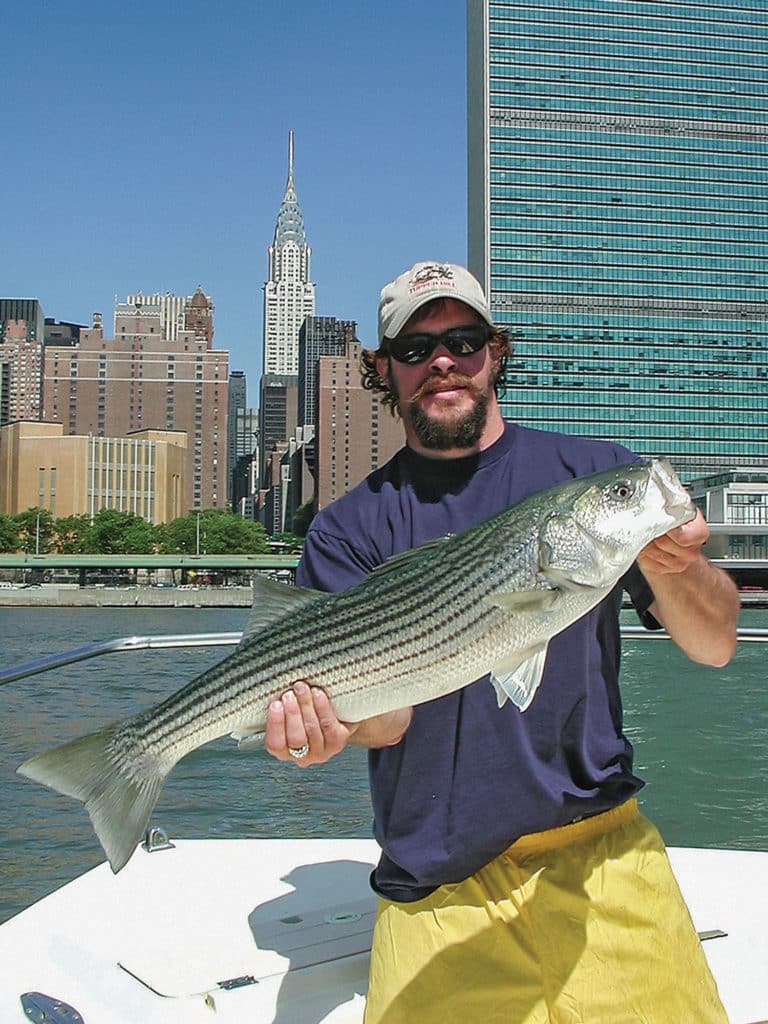
NYC Day Trips
“Who knew this even existed?” asked Paul, a London-based financial advisor, as I pushed the skiff parallel to a grass bank. To the north of us, the sun began to paint the New York City skyline. It wasn’t quite 7 a.m., and we had released more than a dozen striped bass, two of which were well over the 25-pound mark. A Boeing 747 taxied down the runway as Paul shot out 80 feet of line. One pop and a swirl formed underneath the popper. I wanted to say, “You’ve got a follow,” but the turbines had grown loud. Another pop and the water exploded just as the 700,000-pound hunk of metal lifted off from JFK International Airport. “Wow. Surreal.”
Yes, Jamaica Bay, which abuts JFK, offers outstanding light-tackle, shallow-water fishing, but it doesn’t stop there. It can actually be quite good along Manhattan proper. Travel farther east and the Great South Bay offers fantastic flats fishing. Jump farther and Shinnecock can be epic. And is Montauk “The End”? Fuggitaboutit.
Bottom line: If you’re traveling to the city, whether for business or pleasure, there’s more than just sightseeing and good shopping to be had. If you make the effort, awesome day trips await.
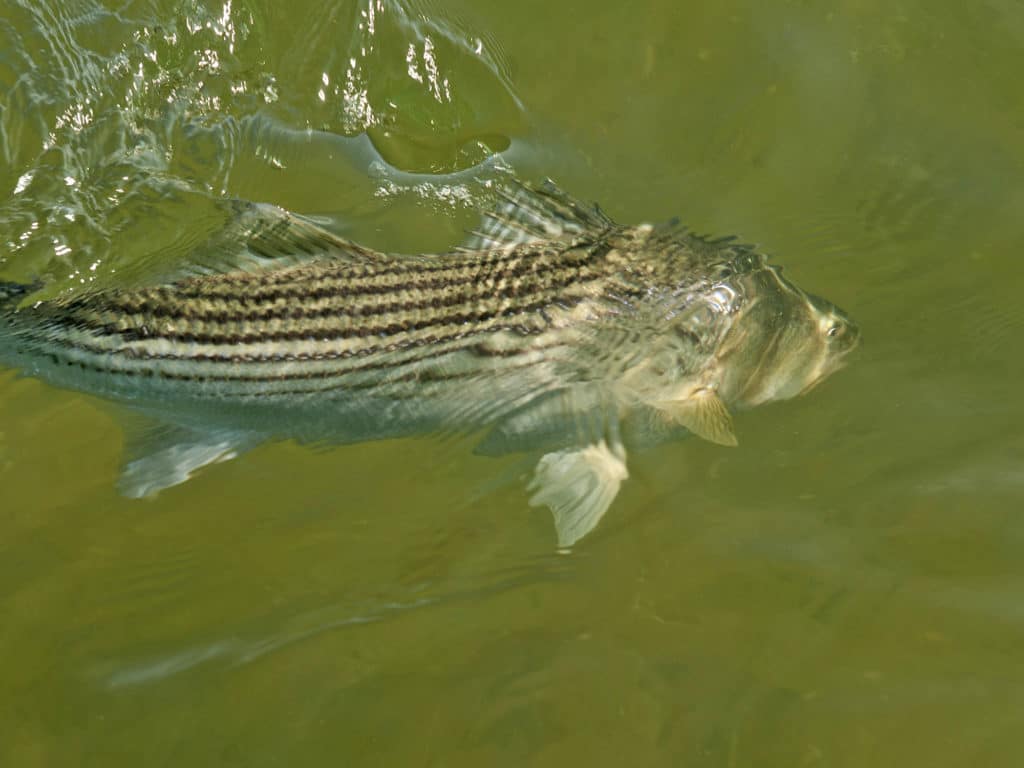
NYC Striper
New York City
Capt. Joe Shastay certainly has such know-how because he’s arguably been doing it the longest. He focuses on pilings and jetties. “I look for the cut where the water pushes around something,” he says. “There are jetties in the East River you wouldn’t know were there, but you can see where they undermine the current, and stripers and bluefish will often stack up there.”
Shastay uses 3/8-ounce jig heads with 4-inch white Mister Twister grubs or Bomber swimming plugs, instructing his anglers to place them in precise spots. He consistently scores with schoolies, but there are days when much larger stripers and crazy-big bluefish are around. “We fish under the lights at night too,” he says. “Sometimes you see them, sometimes you don’t, but most of the time stripers are there.”
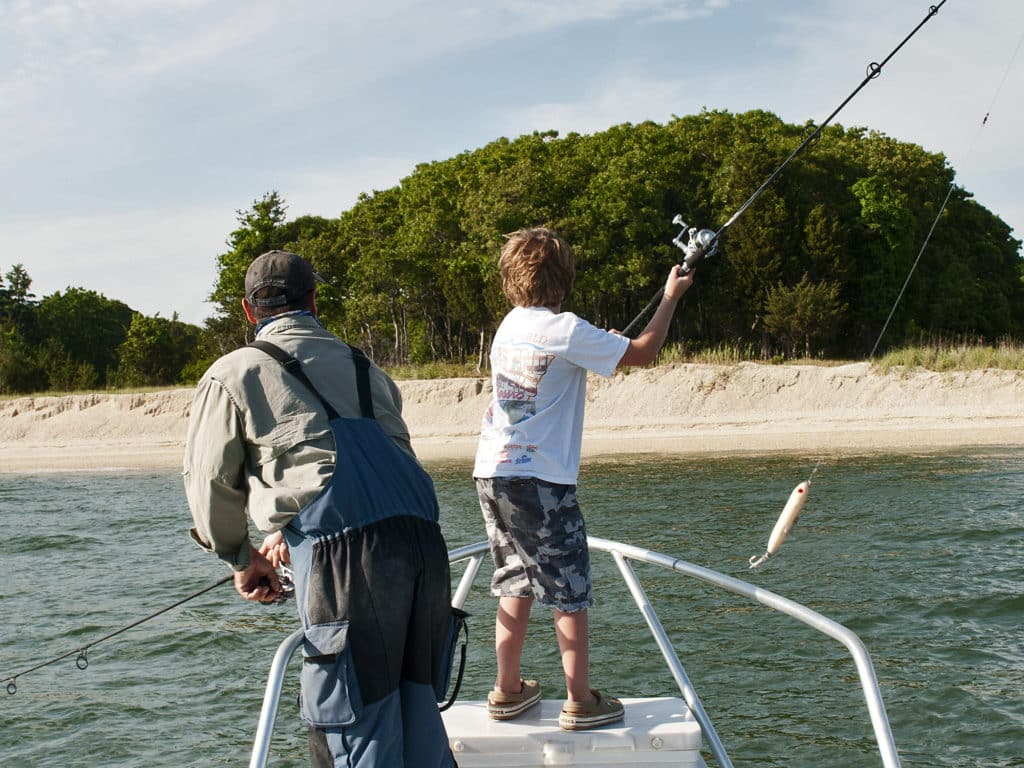
Easy Access
NYC Know-How
Capt. Joe Shastay knows exactly where and how to fish the waters that surround Manhattan, because he’s arguably been doing it the longest. He focuses on pilings and jetties. “I look for the cut where the water pushes around something,” he says. “There are jetties in the East River you wouldn’t know were there, but you can see where they undermine the current, and stripers and bluefish will often stack up there.” Shastay uses 3/8-ounce jig heads with 4-inch white Mister Twister grubs or Bomber swimming plugs, instructing his anglers to place them in precise spots. He consistently scores with schoolies, but there are days when much larger stripers and crazy-big bluefish are around. “We fish under the lights at night too,” he says. “Sometimes you see them, sometimes you don’t, but most of the time stripers are there.”
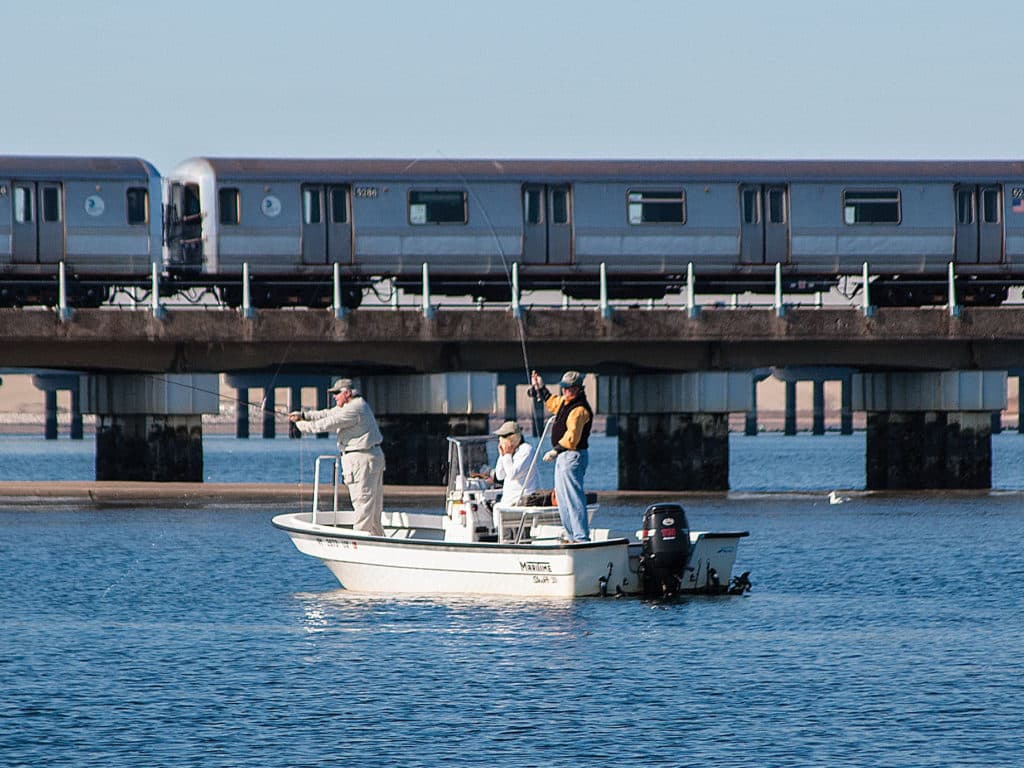
Man-Made Structure
Lower New York Harbor/Raritan Bay
“There are lots of deep channels and big tankers in this area, but fish gravitate toward the abundant man-made structure, providing ample light-tackle opportunities,” says Staten Island guide Capt. Frank Crescitelli. “Islands, rock piles and pilings in water shallow enough you can fish it with light-spin or fly tackle.” You go east or south of the harbor, and if you can’t find birds or bait, you’re out of luck. “But here we have those go-to structure spots that always seem to hold a few fish,” he says.
Crescitelli likes to fish ambush points where water rips around obstructions. He’ll start with small poppers right up against visible structure. “Most of the time, they smash it right up on the rocks on that first pop,” he says, but less aggressive fish require a swimmer or twitchbait. Crescitelli recommends the Guides Secret Baby Bottle Pop and Slim Twitchy.
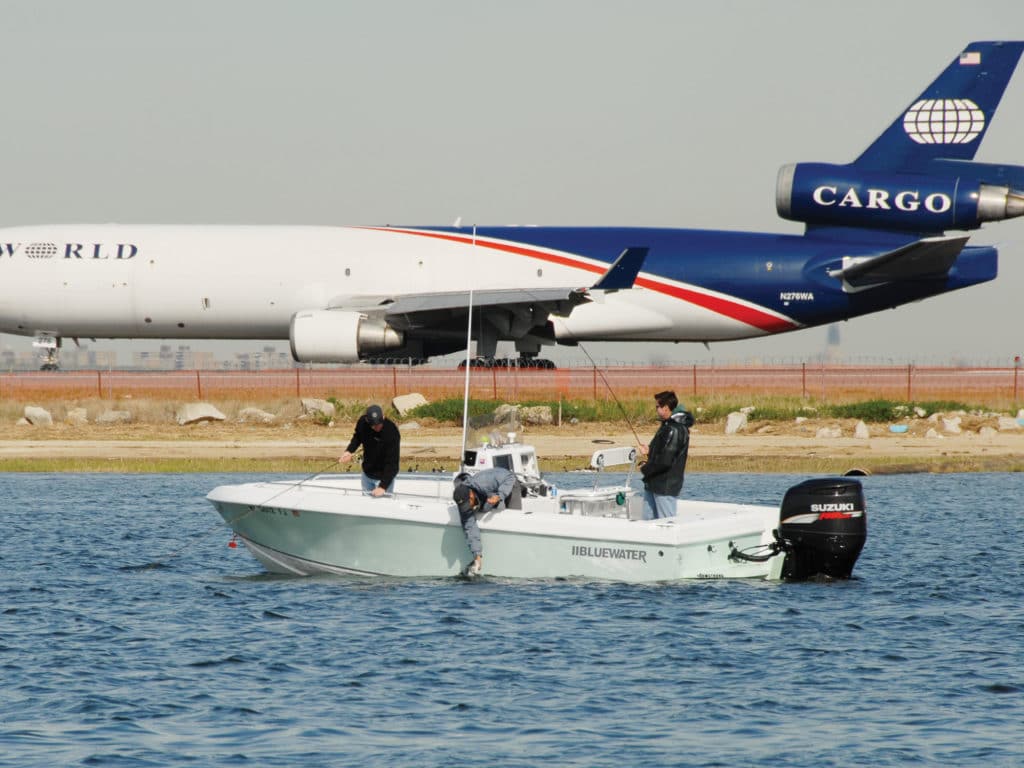
Fishing Jamaica Bay Near JFK Airport
Jamaica Bay: Hidden Jewel
About 12 miles southeast of Manhattan, 10,000 acres of national park and salt-marsh habitat exist smack in the middle of sprawling, overdeveloped Queens, New York. Like most marshes, it has been channelized for boat traffic, but the eastern portion was dredged to create landfill for JFK Airport. There are deep 40-foot bays back by the airport, which are surrounded by the estuarine mud flats and sod banks that teem with life from April to December. Deep water brings in big fish, and the shallow marsh flats bring in the bait.
This is arguably the best and closest light-tackle spot to Manhattan. It’s easy to get to, and when it’s on, it’s crazy good. I spend my springs guiding anglers along the productive sod banks and drop-offs, throwing poppers, sliders, swimming plugs and Slug-Go lures in 2 to 3 feet of water for monster bluefish, striped bass and weakfish. In the fall, the dynamics change a bit, and the drill becomes chasing birds and busting fish.
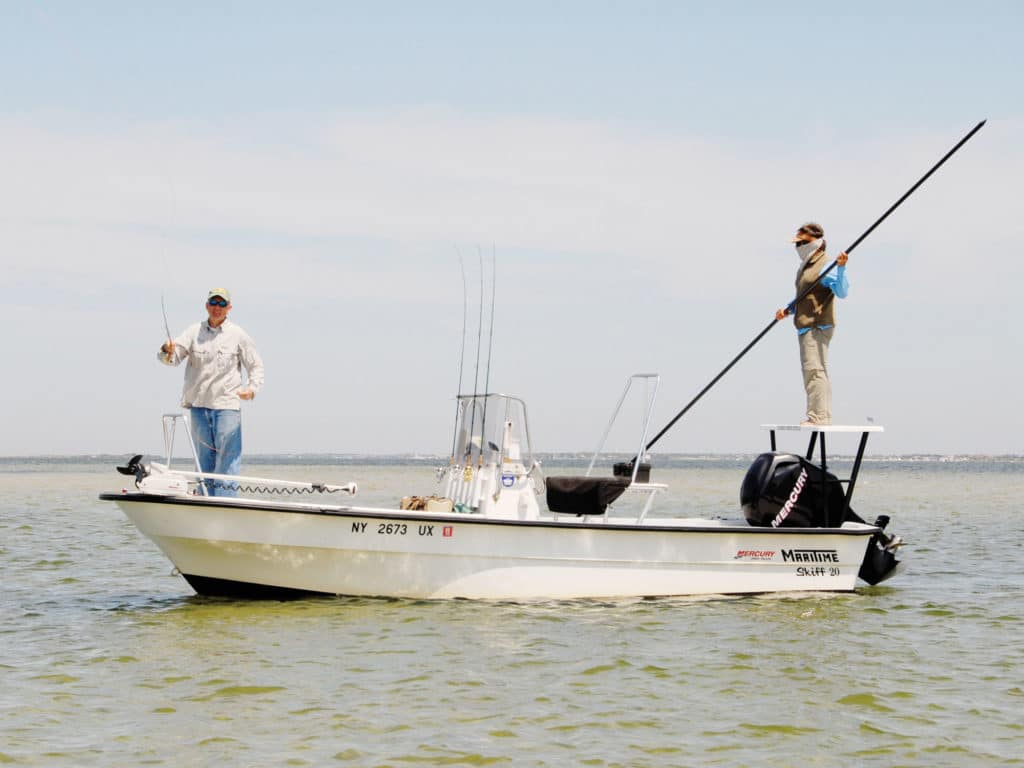
Flats of Great South Bay
Moriches and Shinnecock: The Flats of Great South Bay
The farther east you go on Long Island, the better the water quality and the more you encounter white-sand flats optimal for sight-fishing. There are a couple of OK flats inside Jones Inlet, but where things really get interesting is Fire Island Inlet and east of it. Just inside all three inlets (Fire Island, Moriches and Shinnecock), you find sprawling sand flats with lots of moving water. It’s the closest thing to sight-fishing for bonefish you’ll find up there, except it’s even harder and more challenging. Striped bass often spook easier than bonefish.
To make it even more challenging, the current often runs hard enough to make poling impractical. “A lot of times we just stake out and wait for the fish to come to us,” says flats guide Capt. Bryan Goulart. It is mostly a fly-fishing proposition there because plugs tend to spook fish, but small, unweighted Slug-Go lures also produce.
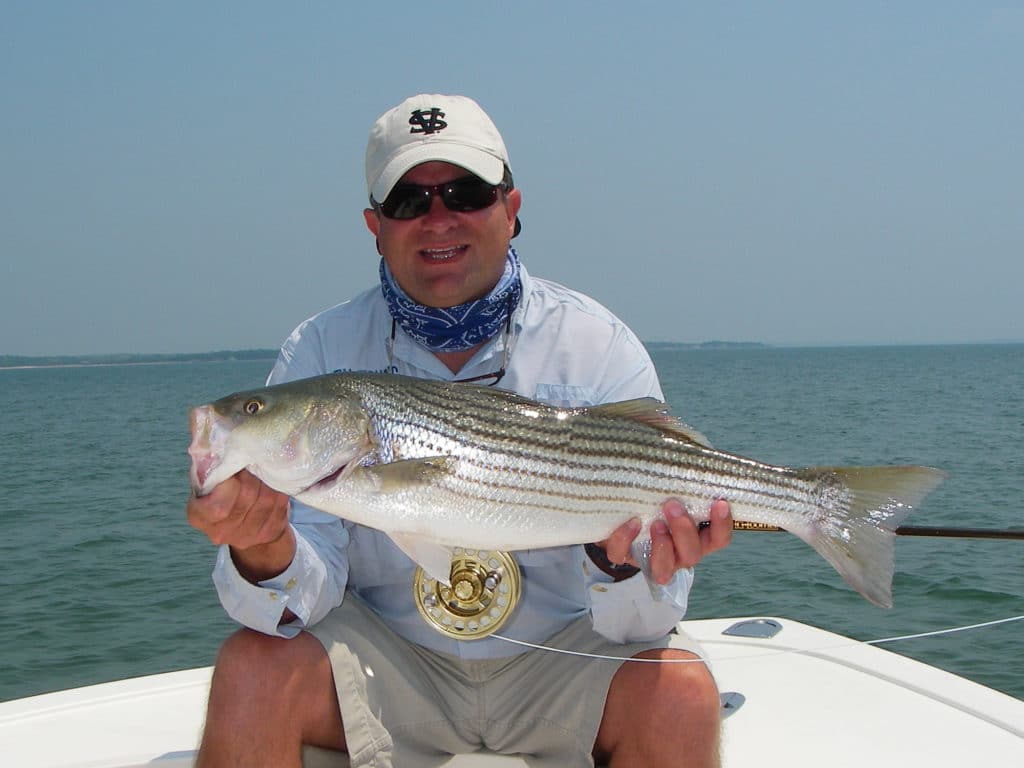
Fishing Famous Montauk
Montauk: The End
I’ll include East Hampton here too because it is pretty close to The End and offers the same exceptional flats sight-fishing described, except it may be easier because there isn’t as much current out there. “We get great sand-eel and crab concentrations in the spring and the summer,” says East End guide Capt. Paul Dixon. “The sight-fishing is some of the best on the east coast.” But, really, this area is all about Montauk. In the fall, it can be insane. Starting in September, the bait in Long Island Sound begins to flood out, and stripers begin to feed heavily in preparation for their annual migration south.
All hell can break loose on any given day. Stripers and bluefish can be so abundant that boils — dense concentrations of feeding fish — happen right up on the beach. From boat and beach, anglers use a variety of baits to target them, but the standards are swimming plugs, poppers, bucktail jigs and tins.
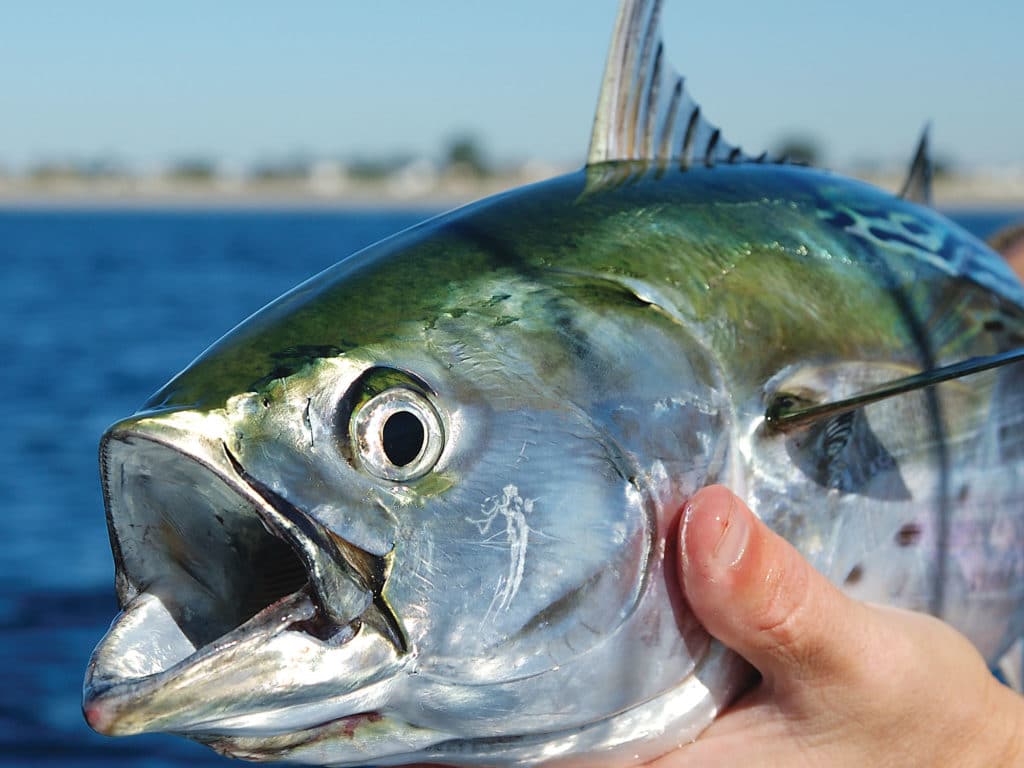
Montauk’s Other Species
Albies Too
And we can’t forget about false albacore. These fast-moving little tunnies flood Montauk in September. They are a blast on light tackle and may be one of the most exciting fish to target on the fly. It’s a run-and-gun fishery, chasing fast-moving schools as they crash bait. Anglers generally target them with small tins called Deadly Dicks, but 4- and 6-inch weightless soft plastics work well too.
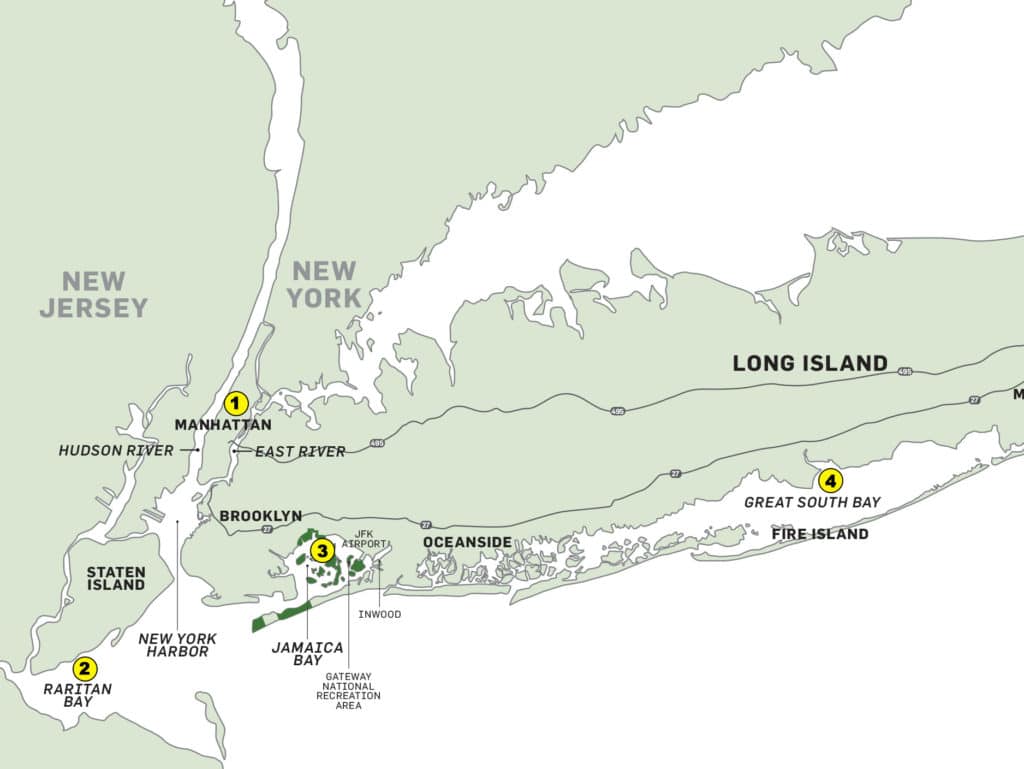
New York’s Top Fishing Locations – Part 1
1. Manhattan: Jetties, dock pilings and bridge abutments in the East and Hudson rivers are ideal rest and ambush points for fish in the fast water.
2. Raritan Bay: An abundance of man-made structure holds baitfish and crustaceans, which, in turn, attract stripers and other predators also.
3. Jamaica Bay: A combination of mud flats, sod banks and deep channels make this an excellent area to stalk stripers, bluefish and flounder.
4. Great South Bay: Cleaner water and extensive white-sand flats make for top sight-fishing, but a fast current often makes poling a challenge.
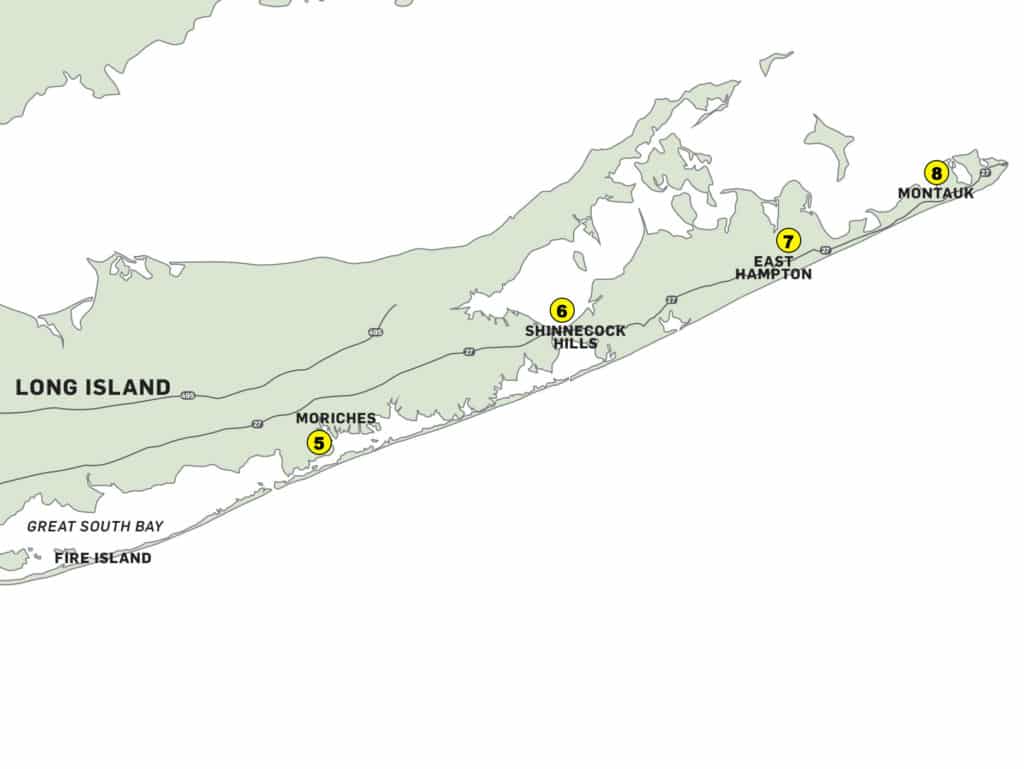
New York’s Top Fishing Locations – Part 2
5. Moriches: Wary fish prowl the clear, shallow waters. For best results, opt for small soft plastics or flies to avoid spooking your quarry.
6. Shinnecock Bay: Vast stretches of light bottom and several small islands along the eastern shore of the bay yield the better action.
7. East Hampton: Slower current and concentrations of sand eels and crabs make the flats of East Hampton particularly productive.
8. Montauk: From August to early October, hordes of stripers, blues and albies come to this legendary place to feast on baitfish moving to open water.
Getting there from Manhattan
Upper and Lower New York Harbor: Capt. Joe Shastay and Frank Crescitelli will pick you up in Manhattan. See their websites for details.
Jamaica Bay: 30- to 40-minute trip. An Uber or car service can take you to the Launch Pad Marina in Inwood, just south of JFK, or Gateway Marina in Brooklyn. You can also take the A train to the Inwood stop, or the Long Island Railroad from Penn Station to the Inwood stop.
Fire Island to Shinnecock: Requires Uber or a car service. Give yourself at least an hour from the city to get to Captree Boat Basin on Fire Island. Getting to Moriches or Shinnecock will likely take two hours. Contact Bryan Goulart for details.
East Hampton and Montauk: Three-hour trip but generally well worth it. Catch a train from Penn Station (Long Island Railroad) to East Hampton/Montauk. The Hampton Jitney (bus) can get you there as well.
Offshore: Want to catch tuna and dolphin on light tackle while visiting New York? In July and August, Capt. John McMurray (onemorecastcharters.net) leaves out of Oceanside, New York, a 40-minute drive from the city. You can cast plugs or even flies at busting yellowfin and bluefin tuna, and/or fish floating structure for mahi-mahi.
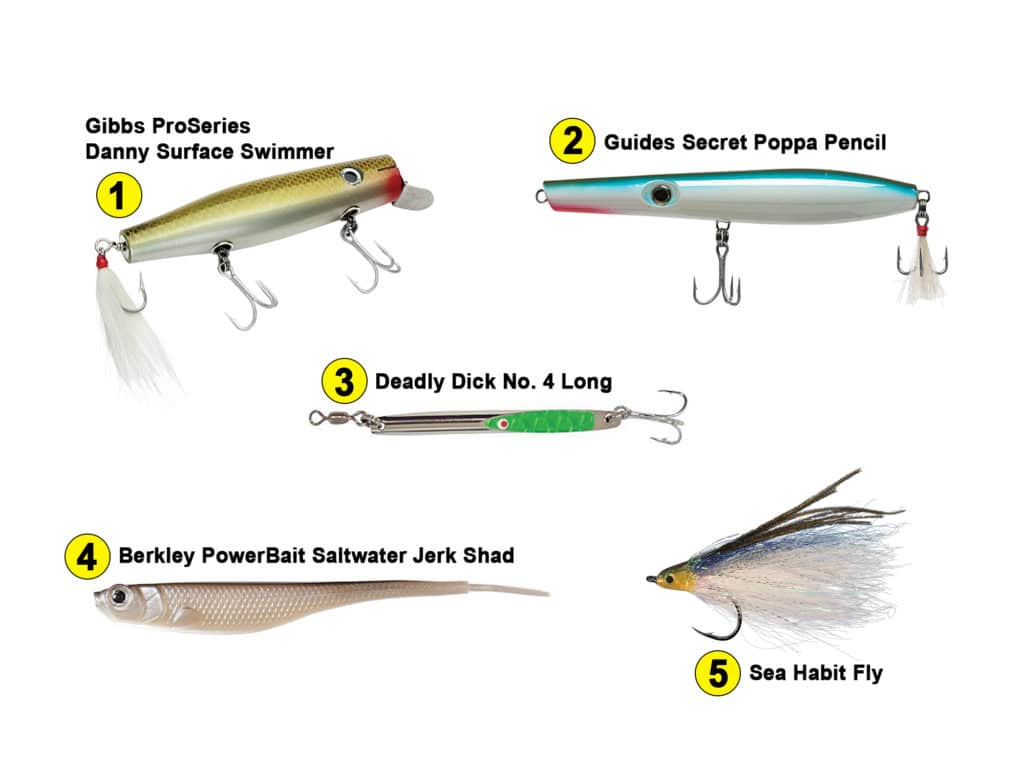
Top New York Tackle Choices
SWS PLANNER: New York City urban waters
What: Light-tackle fishing for striped bass and bluefish
When: May to November
Where: Manhattan to Long Island
Who:These local experts can find the hot bite:
Manhattan: Joe Shastay; nyharborfishing.com
Lower New York Harbor: Frank Crescitelli; finchaser.com
Jamaica Bay: John McMurray; onemorecastcharters.net
Great South Bay to Shinnecock: Bryan Goulart; nysaltfly.com
East Hampton and Montauk: Paul Dixon; flyfishmontauk.com
Offshore Long Island: Capt. John McMurray; onemorecastcharters.net
SWS TACKLE BOX: New York City urban waters
Rods: 7-foot medium to light-action spinning rods
Reels: High-quality 20- to 30-pound class
Line: 20- to 30-pound braid with 4 to 6 feet of 20- to 30-pound fluorocarbon leader
Lures: Poppers, swimming plugs, bucktail jigs (see illustration)









